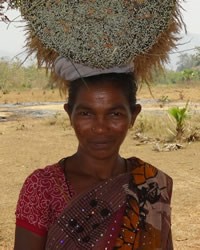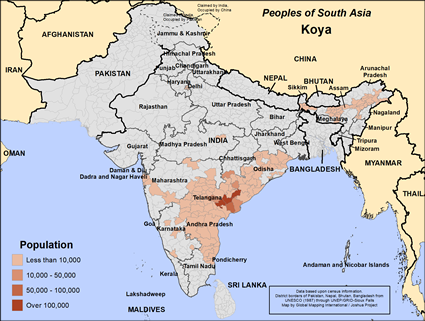The Koya live in the forests, plains, and valleys on both sides of the Godavari River, which lies in the central Indian states of Andhra Pradesh, Telangana, Madhya Pradesh and Odisha. The Koya probably migrated to central India from their original home in Bastar, northern India. They believe their main deity still resides in a cave in the Bastar region. According to Koya mythology, life originated from water.
The Koya language, also called Koyi, is closely related to Gondi and has been strongly influenced by Telugu, the tongue of the neighboring Hindu population. The Koya are one of the few multi-racial and multi-lingual tribal communities in India. Most Koya speak either Gondi or Telugu, in addition to Koyi.
Since India's independence from the British in 1947, the Indian government has increased its influence over the Koya. As a result, the Koya have rebelled numerous times. The Koya resent the restrictions that have been placed on their use of reserve forests and distillation of liquor. They also resent the hydroelectric projects and rehabilitation of refugees in their land.
The Koya are primarily farmers. They once shifted from one plot to another, farming various areas. However, the government has now restricted their movement and has encouraged them to farm on fixed plots. They showed the Koya how to farm coconut and coffee. They also granted the Koya permanent ownership rights to their land if they would grow rice there. In the hill regions occupied by the Koya, there are still no permanent farms. They grow crops in small clearings for only two or three years. Rice and tobacco are the main cash crops for those in the hill regions. Their staple diet is rice.
Because the income from farming is very low, many of the Koya who do not own land work as hired farm laborers. Others weave bamboo baskets and sell them at the weekly markets to Hindu merchants. They also are excellent hunters and this supplements their diet. They are excellent marksmen with a bow and arrow. Koya people gather forest produce to supplement the vegetables grown in their home gardens. Cattle are symbols of wealth, and they keep them for products, meat, fertilizer and trade. They use cattle for religious sacrifices.
The Koya usually live in villages located near dependable water sources. The larger villages are situated near the rivers, while the smaller ones can be found in the hills and jungles.
Most men have one wife, but a few wealthy men have a second wife. Elders and the panchayat (community leaders) decide if a couple can get married. The elders of his family go to her house and give her a blouse; a practical marriage proposal. If her family accepts the proposal, they set a time for the wedding. The Koyas prefer cross-cousin marriages. Often a man will marry his brother's widow. Weddings are usually in the summer.
Panchayats have great power in Koya villages. They act as jury and judge in village disputes. However, they have little power over outsiders.
Dancing and music are very important to the Koya people. Some of it is for recreational purposes while other times, it has religious significance. Their dances can be in honor of certain gods. They have a summer dance where the youths dance and offer prayers to mountain gods, asking for a good harvest, rain and relief from the hot sun. They have a frantic dance where they become possessed by one of the spirits.
The Koya practice their ethnic religion but also worship several Hindu gods and goddesses. Many Koya deities are female, the most important being the "mother earth." Village priests carry out sacrifices. The Koya do not believe in heaven, hell or reincarnation. When a person dies, his body is carried on a cot which is covered with grain, liquor, new clothes, money and a cow's tail. At the appropriate place, the cot is faced towards the West, and the body is burned. The ashes are placed in a clay pot. The Koya believe that their spirits either linger about the clay ancestor pot, patrol the sky over the village, or wander about the village disturbing daily life.
Cholera, smallpox and malaria are big problems for the Koya. They need quality medical care as well as health and hygiene education.
Ask God to give Koya Christians a burden to disciple others in their community.
Pray for Koya people to have such a hunger for truth and righteousness that they embrace Christ no matter what the cost.
Pray for loving and dedicated workers to go to the Koya community.
Scripture Prayers for the Koya unspecified in India.
https://en.wikipedia.org/wiki/Koya_(tribe)
https://www.peoplesoftheworld.org/text?people=Koya
https://www.youtube.com/watch?v=0CSph0kHQ_U
| Profile Source: Joshua Project |











